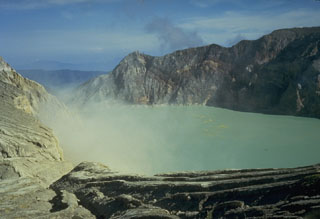Report on Ijen (Indonesia) — November 2002
Bulletin of the Global Volcanism Network, vol. 27, no. 11 (November 2002)
Managing Editor: Richard Wunderman.
Ijen (Indonesia) Above-background seismicity through at least 8 December 2002
Please cite this report as:
Global Volcanism Program, 2002. Report on Ijen (Indonesia) (Wunderman, R., ed.). Bulletin of the Global Volcanism Network, 27:11. Smithsonian Institution. https://doi.org/10.5479/si.GVP.BGVN200211-263350
Ijen
Indonesia
8.058°S, 114.242°E; summit elev. 2769 m
All times are local (unless otherwise noted)
During 9 September through at least 8 December 2002 at Ijen, activity was above background levels. Seismicity was dominated by shallow volcanic (B-type) and tectonic earthquakes (table 5). During the week of 14-20 October, 1 deep-volcanic (A-type) earthquake was registered. Continuous tremor occurred, typically with a maximum amplitude of 0.5-3 mm.
Table 5. Earthquakes reported at Ijen during 9 September-8 December 2002. Courtesy VSI.
| Date | Shallow volcanic (B-type) | Tectonic |
| 09 Sep-15 Sep 2002 | 51 | 4 |
| 16 Sep-22 Sep 2002 | 72 | 5 |
| 23 Sep-29 Sep 2002 | 71 | 6 |
| 30 Sep-06 Oct 2002 | 67 | 5 |
| 07 Oct-13 Oct 2002 | 48 | 6 |
| 14 Oct-20 Oct 2002 | 96 | 2 |
| 21 Oct-27 Oct 2002 | 28 | 2 |
| 28 Oct-03 Nov 2002 | 73 | 2 |
| 04 Nov-10 Nov 2002 | 29 | 1 |
| 11 Nov-18 Nov 2002 | 29 | 17 |
| 02 Dec-08 Dec 2002 | 3 | 1 |
During 2-8 December VSI reported that tremor had a maximum peak-to-peak amplitudes of 0.5-12 mm. Throughout the report period, a "white-thin ash plume" [steam plume] was reported to rise 50-100 m above the volcano. Ijen remained at Alert Level 2.
Geological Summary. The Ijen volcano complex at the eastern end of Java consists of a group of small stratovolcanoes constructed within the 20-km-wide Ijen (Kendeng) caldera. The north caldera wall forms a prominent arcuate ridge, but elsewhere the rim was buried by post-caldera volcanoes, including Gunung Merapi, which forms the high point of the complex. Immediately west of the Gunung Merapi stratovolcano is the historically active Kawah Ijen crater, which contains a nearly 1-km-wide, turquoise-colored, acid lake. Kawah Ijen is the site of a labor-intensive mining operation in which baskets of sulfur are hand-carried from the crater floor. Many other post-caldera cones and craters are located within the caldera or along its rim. The largest concentration of cones forms an E-W zone across the southern side of the caldera. Coffee plantations cover much of the caldera floor; nearby waterfalls and hot springs are tourist destinations.
Information Contacts: Dali Ahmad, Volcanological Survey of Indonesia (VSI), Jalan Diponegoro No. 57, Bandung 40122, Indonesia (URL: http://www.vsi.esdm.go.id/).

